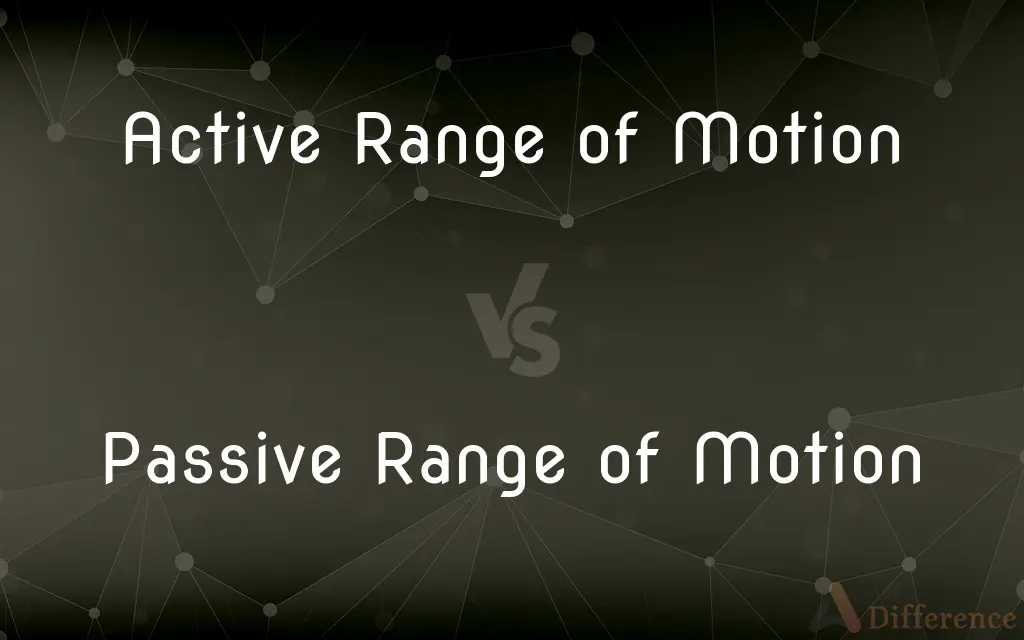Active Range of Motion vs. Passive Range of Motion — What's the Difference?
Edited by Tayyaba Rehman — By Fiza Rafique — Published on December 12, 2023
Active Range of Motion (AROM) is movement initiated and completed by the individual without assistance, while Passive Range of Motion (PROM) involves another person or device moving the joint without muscle activation by the individual.

Difference Between Active Range of Motion and Passive Range of Motion
Table of Contents
ADVERTISEMENT
Key Differences
Active Range of Motion (AROM) and Passive Range of Motion (PROM) are both essential concepts in physical therapy and rehabilitation. Active Range of Motion refers to the movement of a joint through its full mobility using the individual's muscle strength. In contrast, Passive Range of Motion involves the external movement of the joint, typically by a therapist, without any effort from the individual's muscles.
In an assessment or therapeutic setting, Active Range of Motion is often evaluated first. It gives insight into the individual's strength, coordination, and ability to move a joint without assistance. On the other hand, Passive Range of Motion helps therapists understand the potential joint movement and flexibility, excluding muscular limitations.
During Active Range of Motion exercises, the individual actively engages their muscles to move a specific joint or set of joints. For example, bending and straightening the elbow independently is an active movement. In contrast, Passive Range of Motion occurs when the joint is moved without the individual's muscle engagement, like when a therapist moves a patient's arm for them.
Understanding both Active and Passive Range of Motion is vital for rehabilitation and therapeutic interventions. While Active Range of Motion indicates the functional capability of the individual, Passive Range of Motion provides insight into any limitations or restrictions in joint mobility. When these two concepts are combined, they offer a comprehensive view of joint health and function.
Comparison Chart
Initiation
By the individual themselves
By an external force (e.g., therapist or device)
ADVERTISEMENT
Muscle Engagement
Requires muscle activation by the individual
No muscle activation by the individual
Purpose
Assesses strength, coordination, and joint mobility
Determines joint flexibility without muscular limits
Example
Bending one's own knee
Therapist bending the individual's knee
Utilized in
Rehabilitation to improve muscle function
Rehabilitation to improve joint flexibility
Compare with Definitions
Active Range of Motion
The extent an individual can move a joint without external help.
His Active Range of Motion was limited due to muscle weakness.
Passive Range of Motion
External movement of a joint, excluding individual's effort.
After his accident, the Passive Range of Motion exercises helped maintain joint health.
Active Range of Motion
Self-initiated joint movement through its full mobility.
He demonstrated a full Active Range of Motion in his shoulder during the assessment.
Passive Range of Motion
Movement of a joint without muscle activation by the individual.
The therapist checked her Passive Range of Motion to understand joint flexibility.
Active Range of Motion
Joint motion gauging individual strength and coordination.
Active Range of Motion exercises are crucial for recovering muscle functionality post-injury.
Passive Range of Motion
The extent a joint can be externally moved without muscle engagement.
Due to stiffness, her Passive Range of Motion was less than the average range.
Active Range of Motion
Muscle-driven movement of a specific joint or set of joints.
She performed Active Range of Motion exercises daily to strengthen her ankle.
Passive Range of Motion
Movement initiated by an external force without individual's muscle use.
Passive Range of Motion exercises are beneficial for individuals with severe muscle weakness.
Active Range of Motion
Movement of a joint using one's muscle strength.
After her surgery, she worked on increasing her elbow's Active Range of Motion.
Passive Range of Motion
Joint mobility assessment without considering muscular limitations.
The Passive Range of Motion test showed that there was no joint restriction.
Common Curiosities
When is Passive Range of Motion typically used?
It's used to maintain or improve joint flexibility, especially when an individual can't move the joint on their own.
How does Passive Range of Motion differ from Active Range of Motion?
PROM involves external movement of a joint without individual's muscle activation, while AROM is self-initiated.
Can both AROM and PROM be used in the same therapy session?
Yes, both can be combined to offer a comprehensive approach to joint health and function.
Why is Active Range of Motion important in rehabilitation?
It assesses and improves the individual's muscle strength, coordination, and joint mobility.
How can one improve their Active Range of Motion?
Through targeted exercises, strength training, and consistent physical therapy.
What is Active Range of Motion?
It refers to movement of a joint initiated and completed by the individual without assistance.
Why is Passive Range of Motion significant in therapy?
It provides insight into joint mobility without the influence of muscular limitations.
Does Active Range of Motion always indicate joint health?
Not entirely. AROM indicates functional capability, but a joint might still have issues not apparent during active movement.
Can a person have a full Active Range of Motion but limited Passive Range of Motion?
It's rare; typically, AROM is less than or equal to PROM due to muscle limitations.
Is Passive Range of Motion always safe?
While generally safe, excessive or forceful PROM can cause injury. It should be done by trained professionals.
Share Your Discovery

Previous Comparison
East Coast Time vs. West Coast Time
Next Comparison
Sense Strand of DNA vs. Antisense Strand of DNAAuthor Spotlight
Written by
Fiza RafiqueFiza Rafique is a skilled content writer at AskDifference.com, where she meticulously refines and enhances written pieces. Drawing from her vast editorial expertise, Fiza ensures clarity, accuracy, and precision in every article. Passionate about language, she continually seeks to elevate the quality of content for readers worldwide.
Edited by
Tayyaba RehmanTayyaba Rehman is a distinguished writer, currently serving as a primary contributor to askdifference.com. As a researcher in semantics and etymology, Tayyaba's passion for the complexity of languages and their distinctions has found a perfect home on the platform. Tayyaba delves into the intricacies of language, distinguishing between commonly confused words and phrases, thereby providing clarity for readers worldwide.












































